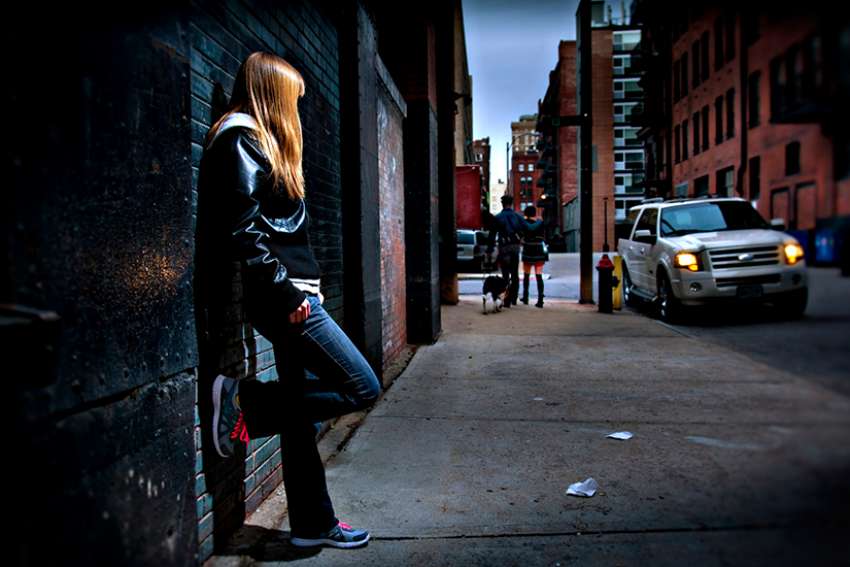Photo illustration of a young woman depicts the effects of human trafficking. Robert Kinghorn writes that the good news of the Church on the Street is not reported alongside the murders and the overdoses in secular newspapers.
CNS illustration/Lisa Johnston, St. Louis Review
Amid violence streets still have their moments of grace
By Robert Kinghorn
There are few, if any, parishes in Toronto that had three shooting deaths in the first month of the year and followed them up with two more in the next few months. Add to this an epidemic of drug overdoses and a picture of lawlessness could emerge.
This has been the fate of the Church on the Street this year, and has impelled me to spend more time in the areas where violence has escalated.
Not that violence is a stranger to the parish boundaries, as was documented by an article by Mark Bonokoski in The Toronto Sun 10 years ago which described the area in these despairingly tragic words: “A patch of inner-city Toronto plagued by crack addicts, drug-dealers and low-rent sex trade workers. A part of the city where lost souls are not unusual... A stretch of the inner-city, unfortunately, that is beset by rooming houses and transiency, and so disappearances tend to go unnoticed.” It was the reference to lost souls becoming the norm and disappearances going unnoticed that was an inspiration for me in the early days. Not that my role is to save souls, since that is the realm of grace, and as my friend Deacon Mike Walsh sagely points out, we disciples are in marketing, not management. However, the pervasive sense that it is acceptable for disappearances to go unnoticed disturbed and animated me.
One summer evening I was walking through these streets, “plagued by crack addicts, drug-dealers, and low-rent sex trade workers,” when my eye was caught by a particular young man in the distance, sheltered by the shade of the trees. Judgmental as this may have been, I assessed he was not awaiting the rapture unless it was drug-induced and imminent. As I walked by him he saw my clerical collar and asked, “Are you a priest?”
“Well, I’m a Catholic deacon I said,” forgoing the theological distinction between the two.
“My name is Junior and I want to confess my sins,” he said, “but not in one of these boxes, but right here on the street.”
“Let’s talk,” I replied.
Before he could speak, a police car slowly drove by with the window down and one of the police officers leaned out and shouted, “How are you tonight Junior? Is everything OK?”
Faking indignation, Junior shouted after him, “Now you have told him my name,” he laughed, “you know that’s a dangerous thing to do on these streets.” The car continued down the street as the officer looked out and laughed, and we picked up our conversation where we had left off. As I left Junior after our discussion, I gave him my phone number and told him to call me any time.
I had gone about 100 metres along the street when I heard a text message summon me to the phone. It was from Junior and the words simply read, “You will never know how much that meeting meant to me. Thank you.”
He was correct I will never know, at least in this life. The meeting had left me confused and not a little emotional. It was something about the interaction of Junior with the police officer combined with his honesty and unexpected text that did not make sense. I stood and mulled it over thinking of all the possible angles. Was he a police informant, an undercover police officer or a dealer having fun with me? None of these made any sense and I was left only with the stark reality of the meeting. I have learned not to ask why for what happens on the streets, but I have to say I am still haunted by this meeting. Future calls to his phone went unanswered and I have to accept that this was a moment of grace for both of us that will remain an unexplained mystery into eternity.
In the Gospel of Luke, we read that there will be more joy in Heaven over one sinner who repents than over 99 righteous persons who need no repen-tance. This is good news, but unfortunately the good news of the Church on the Street is not reported alongside the murders and the overdoses in secular newspapers, and so we are left with the prevailing sense of lawlessness.
This does a gross injustice to the thousands of “parishioners” who in their saintly poverty have entrusted their lives to God, and to the countless others who are longing to find their way home to a loving and merciful Father.
(Kinghorn is a deacon of the Archdiocese of Toronto: robert.kinghorn@ekinghorn.com.)
Please support The Catholic Register
Unlike many media companies, The Catholic Register has never charged readers for access to the news and information on our website. We want to keep our award-winning journalism as widely available as possible. But we need your help.
For more than 125 years, The Register has been a trusted source of faith-based journalism. By making even a small donation you help ensure our future as an important voice in the Catholic Church. If you support the mission of Catholic journalism, please donate today. Thank you.
DONATE

